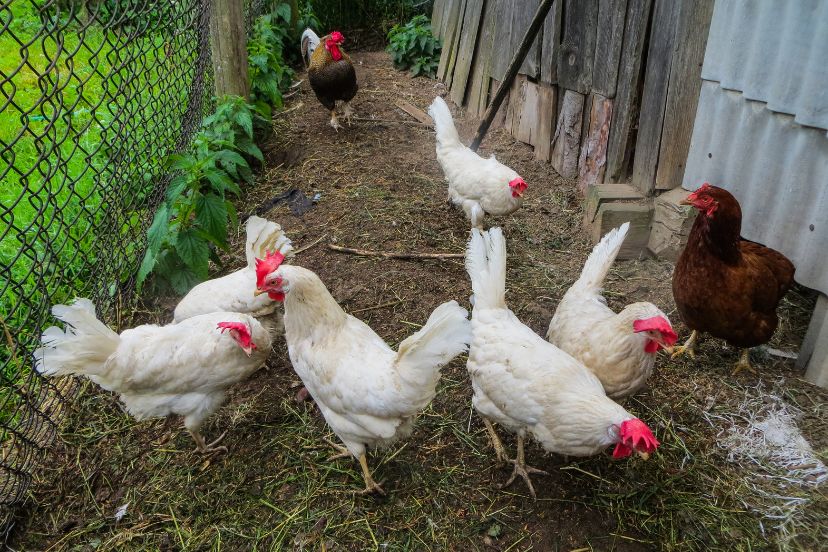California White Chickens: The Feathered Wonder of the West
California White Chickens are a breed that has captured the hearts of many poultry enthusiasts. Their elegance, productivity, and adaptability make them a top choice for both commercial farmers and backyard hobbyists. Let’s explore further.
History and Origin
The 20th century saw significant advancements in many fields, including poultry breeding. Amidst this backdrop, the California White Chicken emerged as a symbol of innovation in the poultry industry. A breed “born” in the 1900s might be considered “new” in the grand timeline of domesticated chickens, especially when compared to ancient breeds that have been around for centuries.
Parentage: Leghorn and Black Minorca
The creation of the California White Chicken is the result of intentional crossbreeding between two esteemed breeds: the Leghorn and the Black Minorca.
Known worldwide for its remarkable egg-laying prowess, the Leghorn chicken is a medium-sized bird, often white, and embodies efficiency. Their hardiness and prolific egg production have made them a cornerstone in the commercial egg industry.
Larger than the Leghorn and draped in a sleek black plumage, Black Minorcas are not just about looks. They too are good layers, producing large white eggs. Their distinctive feature, however, is their large comb and wattles, giving them a unique silhouette.
Resultant Features
This union between the Leghorn and Black Minorca has led to a bird that possesses an amalgamation of desirable traits:
Physical Appearance: The California White inherits its primary white color from the Leghorn but is punctuated by random black spots, a nod to its Black Minorca parentage. This dappled appearance sets them apart, giving them an exotic yet familiar feel.
Egg-Laying Abilities: As descendants of two prolific layers, it’s no surprise that the California White has inherited this prodigious egg-laying trait. They consistently lay large, white eggs, becoming an asset to any backyard poultry enthusiast or commercial farmer.
Personality Traits: While chickens aren’t usually lauded for their personalities, those familiar with the California White often describe them as friendly and sociable. The harmonious blend of the Leghorn’s vigor and the calm disposition of the Black Minorca results in a bird that’s both lively and amiable. It’s like combining the vivacity of a toddler with the composed nature of an elder—simply delightful!
The Benefits of Raising California Whites
The journey of raising poultry is a diverse one, with each breed bringing its unique set of advantages. Among them, California Whites stand out, offering an array of benefits that appeal to both novice and seasoned poultry enthusiasts.

Low Maintenance Needs
Adaptable Friends: One of the primary attractions of California Whites is their innate adaptability. Think of them as the hardy plants in a garden, resilient and robust. They don’t demand special conditions, nor do they pout in the face of mild adversity.
Weather Resilience: Whether you’re in an area that experiences the scorching sun, cold winds, or seasonal showers, California Whites tend to take it in stride. It’s as if they come with a built-in resilience mode, ready to face diverse climates.
Feeding Simplicity: They aren’t the type to turn up their beaks at standard poultry feed. A balanced diet will keep them happy, negating the need for any special culinary concoctions.
Social Dynamics: Additionally, their social demeanor makes integrating them into a mixed flock easier. No unnecessary drama or coop politics!
Excellent Egg Production
Consistent Layers: If egg-laying was a sport, California Whites would be among the Olympians. They lay consistently, ensuring a steady stream of eggs. No more waiting and wondering when the next batch will come.
Quality Over Quantity (But Still Plenty of Quantity!): It’s not just about the number of eggs but also their quality. Their eggs are often large and have a robust shell, a clear indication of the health and vigor of the chicken.
Economic Advantage: For those considering poultry as a commercial venture, this breed can be a wise choice. Their consistent egg-laying abilities can translate into steady income. Think of them as little feathery entrepreneurs, contributing to the household!
Satisfying Breakfasts: There’s a distinct joy in collecting fresh eggs in the morning, knowing that they’ve come from happy, healthy hens. Your breakfasts suddenly become gourmet experiences, whether you prefer them boiled, fried, scrambled, or poached.
Raising California White Chickens is akin to having a reliable, high-performing vehicle. They demand little, yet offer a lot in return. Their low maintenance requirements combined with their impressive egg-laying prowess make them a jewel in the poultry realm. Whether you’re raising chickens for companionship, eggs, or both, California Whites prove to be a remarkable choice, blending efficiency with simplicity.
Housing Requirements
Just like any creature, the environment in which California Whites reside plays a pivotal role in their well-being. Think of their housing as their personal sanctuary. A spacious coop is akin to a luxurious penthouse suite for these birds, providing them with the comfort and security they need to thrive. While they’re not overtly demanding, the coop should be roomy enough to allow them freedom of movement, prevent overcrowding, and ensure ample ventilation.
Outside the coop, an open run area is essential. This is their playground, where they can stretch their legs, forage, and engage in natural chicken behaviors. Providing them with this space is like gifting them a sprawling backyard garden. Not only does it contribute to their physical health by offering exercise opportunities, but it also promotes their mental well-being, ensuring they remain active, engaged, and chirpy.

Read our article Backyard Chicken Coops: All You Need to Know for more information.
Feeding Guide
Dietary monotony isn’t just a human grievance; our feathery friends too crave culinary diversity. Imagine being served the same dish every single day – even the idea sounds tedious. Similarly, California Whites flourish when their menu is diverse and balanced. Offering them a mere singular feed would be akin to subjecting them to an eternal spinach diet.
To keep these birds at their healthiest and happiest, it’s imperative to provide a mixture of grains, greens, and proteins. Grains like corn, wheat, and oats form the foundational carbs, while fresh vegetables add necessary vitamins and minerals. For the protein punch – crucial for their growth, egg production, and feather health – occasional servings of mealworms, insects, or even a quality poultry pellet mix works wonders. This balanced blend ensures they get the right nutrients in the right proportions, mirroring a gourmet three-course meal rather than a repetitive single dish.
Health and Common Issues
While California Whites are celebrated for their robustness, it’s a misconception to believe they’re invincible shields against poultry maladies. Like all living beings, they too have their vulnerabilities. Equating their hardiness to an armor might be apt, but even the toughest armors can have chinks. This is where the importance of vigilance and proactive care enters the scene.
Regular check-ups are not mere formalities but essential wellness routines. It’s during these sessions that early signs of illnesses can be spotted and nipped in the bud. Imagine these check-ups as their exclusive spa days – an opportunity for rejuvenation and thorough scrutiny. Moreover, vaccinations act as the protective layer, preventing several common diseases from taking root.
In essence, while these chickens might come across as low-maintenance warriors of the poultry world, they still require and deserve consistent healthcare attention. After all, prevention is always better than cure, especially when the well-being of our feathery friends is at stake.
Breeding California White Chickens
Breeding California White Chickens is a fascinating journey that intertwines science, nature, and a bit of serendipity. As offspring of the Leghorn and Black Minorca lineage, these chickens have a rich genetic tapestry that makes breeding them an intriguing endeavor.
The first step in breeding California Whites is selecting the right pair. Just like any matchmaking endeavor, you’d want to ensure both the rooster and the hen are healthy, active, and of optimal breeding age. It’s akin to choosing the finest ingredients for a gourmet recipe; the quality of the result often mirrors the quality of the starting materials.
Once the breeding pair is established, ensuring their environment is conducive to reproduction is pivotal. This involves providing them with a quiet, spacious nesting area, free from disturbances and stressors. This nesting space acts as their intimate haven, setting the stage for successful egg fertilization.
However, a key point to remember is that breeding California Whites won’t always yield chicks with the exact dappled appearance. Due to their hybrid nature, their offspring can showcase a range of patterns and colorations, making each breeding cycle a bit like a genetic lottery. This unpredictability adds a layer of excitement to the process.
In conclusion, breeding California White Chickens is not just about producing more of the same breed, but it’s an opportunity to witness the wonders of genetics in action. With the right approach and conditions, breeders can enjoy the gratification of nurturing the next generation of these magnificent birds.
Unique Personality Traits
At the heart of the California Whites’ appeal isn’t just their aesthetic allure but their vibrant personalities. These birds are a delightful blend of zest, sociability, and a sprinkle of cheeky unpredictability, much like an intriguing protagonist in a classic novel.
Their active nature is immediately noticeable. They’re the kind of birds that seem to be in perpetual motion, whether they’re foraging, exploring, or simply flitting around. This vivacity ensures that there’s rarely a dull moment in their presence. Watching a California White go about its day is akin to witnessing a dancer lost in a passionate performance.
Friendliness is another feather in their cap. These chickens, more often than not, are approachable and amiable. They tend to integrate well with other breeds and can form bonds with their human caretakers. For many poultry enthusiasts, this friendly disposition makes interactions with California Whites feel like catching up with an old friend.
However, they’re not always the easy-going, sociable birds on the block. Just like humans have their off days, California Whites can sometimes exhibit a more reserved, elusive demeanor. They might play hard-to-get, teasingly staying just out of arm’s reach or giving you a coy look from a distance. But, isn’t this unpredictability what makes personalities rich and layered?
In essence, California Whites are a bundle of contrasts – they’re vivacious yet can be coy, friendly but occasionally aloof. This blend of traits ensures that life with them is always engaging, filled with moments of joy, amusement, and the occasional chase around the coop!
| Read Next: |
Five Friendliest Chicken Breeds to Own
FAQs
How often do California Whites lay eggs? They lay almost every day. Think of it as their daily gift to you!
What’s their lifespan? With proper care, they can live for 5-7 years. That’s several years of companionship!
Are they good with children? Absolutely! Their gentle disposition makes them family favorites.
Can they tolerate cold? Yes, but ensure they have a warm coop during chilly nights. Who doesn’t love a cozy blanket, right?
Where can I buy California White Chickens? Most local poultry farms and online hatcheries have them. It’s like shopping online, but way more feathery!




